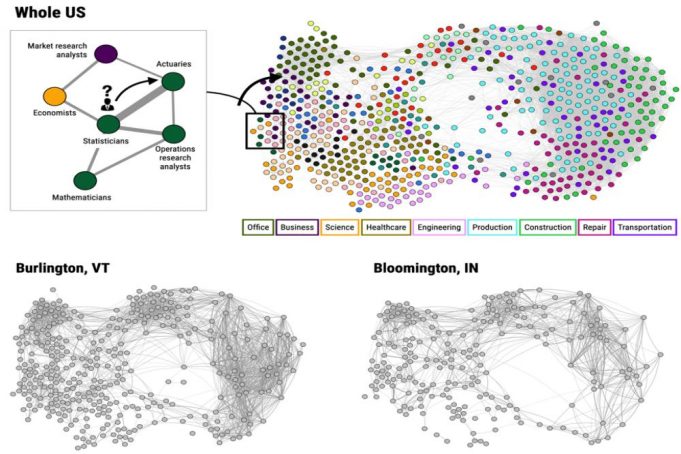Job connectivity improves resiliency in US cities, study finds

New research offers insight for city planning and workforce development.
What makes urban labor markets more resilient? This is the question at the heart of a new study published in Nature Communications by members of MIT’s Connection Science Group. The researchers in this study, including MIT research scientist and Universidad Carlos III (Spain) Professor Esteban Moro; University of Pittsburgh professor and former MIT postdoc Frank Morgan, MIT Professor Alex “Sandy” Pentland, and Max Planck professor and former MIT professor Iyad Rahwan, drew on prior network modeling research to map the job landscapes in cities across the United States, and showed that job “connectedness” is a key determinant of the resilience of local economies.
Economists, policymakers, city planners, and companies have a strong interest in determining what factors contribute to healthy job markets, including what factors can help promote faster recovery after a shock, such as a major recession or the current Covid-19 pandemic. Traditional modeling approaches in this realm have treated workers as narrowly linked to specific jobs. In the real world, however, jobs and sectors are linked. Displaced workers can often transition to another job or sector requiring similar skills. In this way, job markets are much like ecosystems, where organisms are linked in a complex web of relationships.
In ecology and other domains where complex networks are present, resilience has been closely linked to the “connectedness” of the networks. In nature, for example, ecosystems with many mutualistic connections have proven more resistant to shocks, such as changes in acidity or temperature, than those with fewer connections. By drawing on ecosystem-inspired network models and extending the Nobel Prize-winning Pissarides-Mortensen job matching framework, the authors of the new study modeled the relationships between jobs in cities across the United States. Just as connectedness in nature fosters resilience, they predicted that cities with jobs connected by overlapping skills and geography would fare better in the face of economic shock than those without such networks.
To validate this, the researchers examined data from the Bureau of Labor Statistics for all metropolitan areas in the country from the onset to the end of the Great Recession (December 2007-June 2009). They were able to create job landscape maps for each area, including not just the numbers of specific jobs, but also their geographical distribution and the extent to which the skills they required overlapped with other jobs in the area. The size of a given city, as well as its employment diversity, played a role in resilience, with bigger, more diverse cities faring better than smaller and less-diverse ones. However, controlling for size and diversity, factoring in job connectivity significantly improved predictions of peak unemployment rates during the recession. Cities where job connectivity was highest leading up to the crash were significantly more resilient and recovered faster than those with less-connected markets.
Even in the absence of temporary crises like the Great Recession or the Covid-19 pandemic, automation promises to upend the employment landscapes of many areas in coming years. How can cities prepare for this disruption? The researchers in this study extended their model to predict how job markets would behave when facing job loss due to automation. They found that while cities of similar sizes would be affected similarly in the beginning phases of automation shocks, those with well-connected job networks would provide better opportunities for displaced workers to find other jobs. This provides a buffer against widespread unemployment, and in some cases even leads to more jobs being created in the aftermath of the initial automation shock. A city like Burlington, Vermont, where job connectivity is high, would fare much better than Bloomington, Indiana, a similar-sized city where job connectivity is low.
The findings of the study suggest that policymakers should consider job connectivity when planning for the future of work in their regions, especially where automation is expected to replace large numbers of jobs. Not only does increased connectivity result in lower unemployment — it also contributes to a rise in overall wages. Furthermore, in individual occupations, workers in jobs that are more “embedded” (connected to other jobs) in a region earn higher wages than similar workers in areas where those jobs are not as connected.
These results offer fresh insight to help steer discussions about the Future of Work and may help guide and complement current decisions about where to invest in job creation and training programs.
MIT Connection Science is a research group hosted by the Sociotechnical Systems Research Center, a part of the Institute for Data, Systems, and Society.


